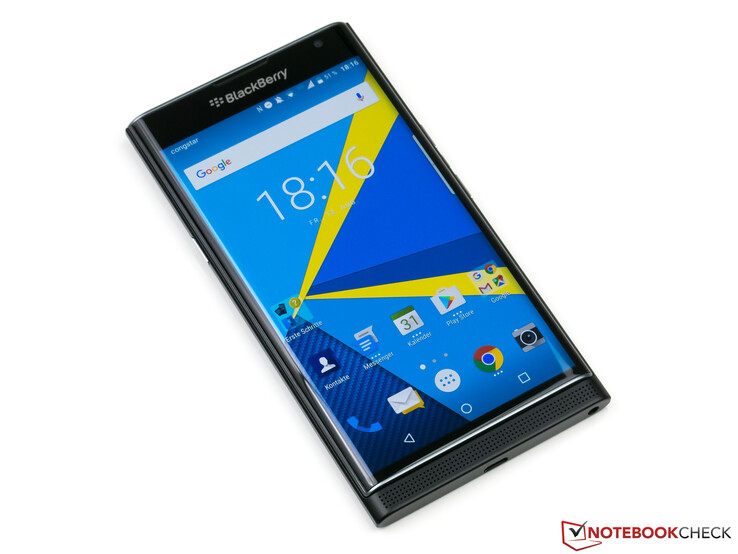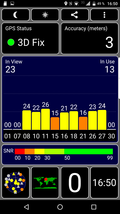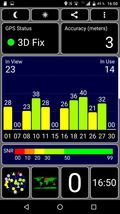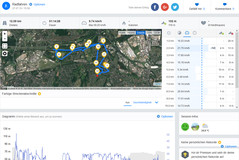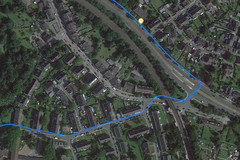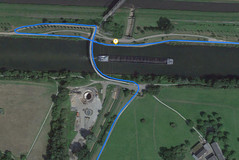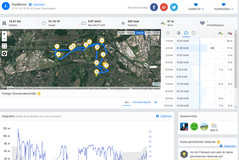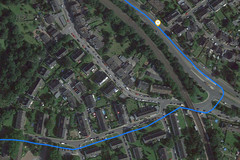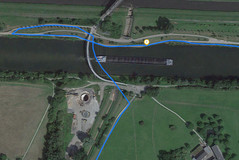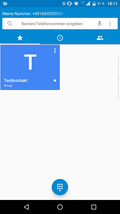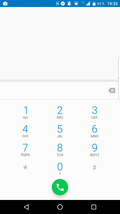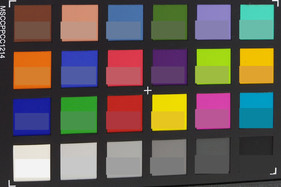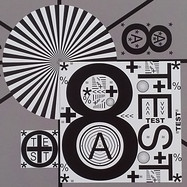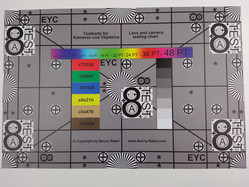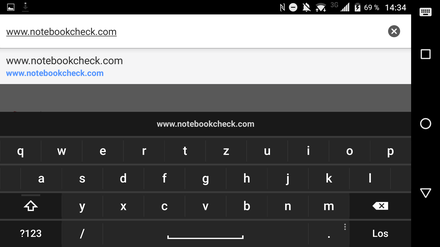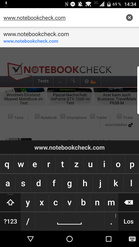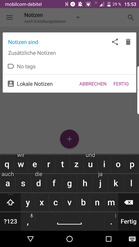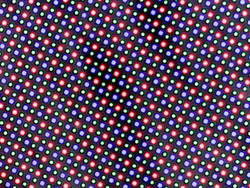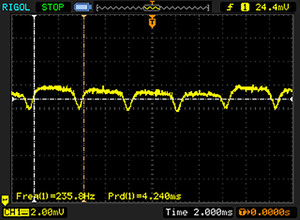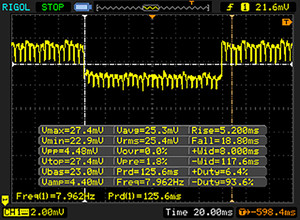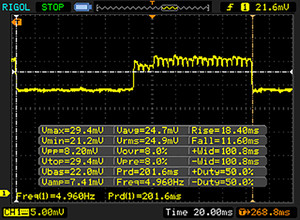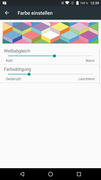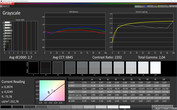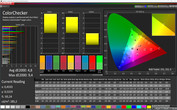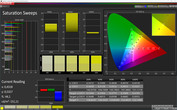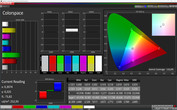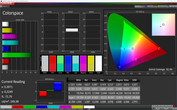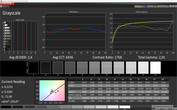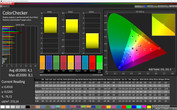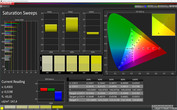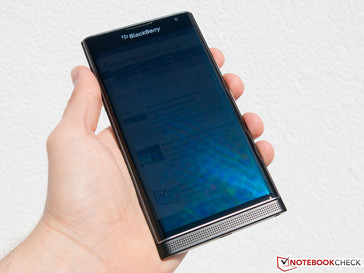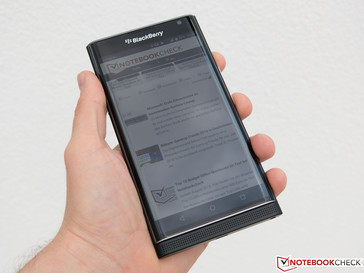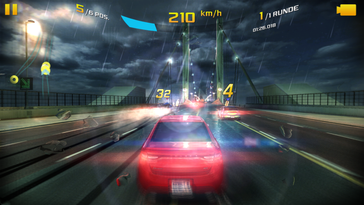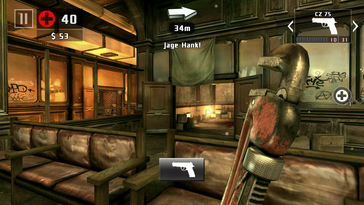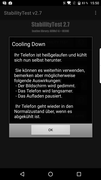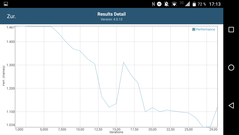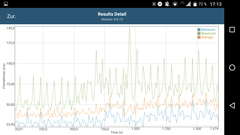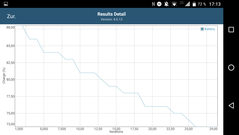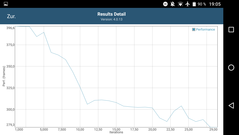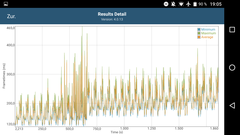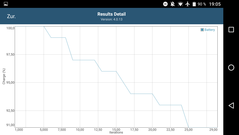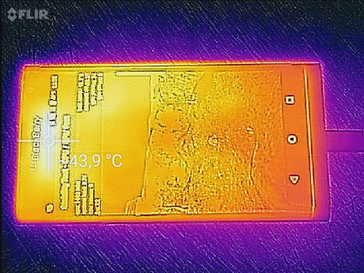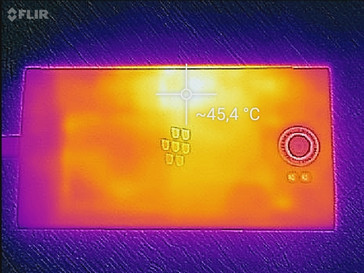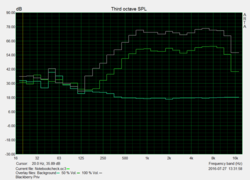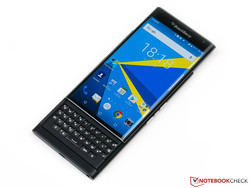BlackBerry Priv Smartphone Review
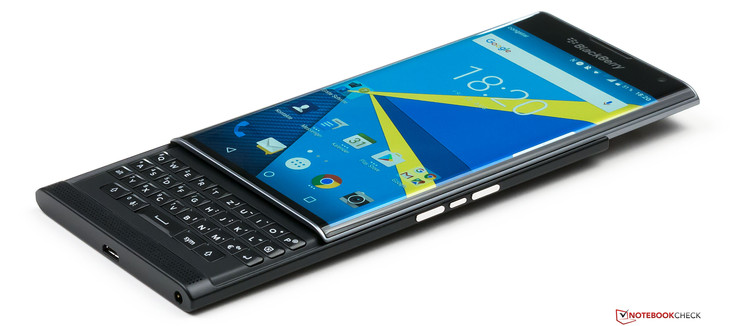
For the original German review, see here.
Until now, Blackberry has always used its own software. However, the manufacturer listens to the masses for its latest Priv top model and relies on the widely distributed Android operating system. The smartphone will thus likely become more interesting for new target groups outside traditional business customers. However, the relatively high price of 779 Euros (~$883) at market launch (late 2015), which has only dropped moderately to 650 Euros (~$737), may deter buyers. In terms of hardware, the device is based on a Snapdragon 808 SoC that is supported by 3 GB of RAM, and a 5.4-inch AMOLED panel. The internal storage of 32 GB is common in the category and it can be expanded via a micro-SD card. The slide-out, physical keyboard in the Priv is a real unique selling point.
Owing to its positioning in the premium price range, the review sample faces top models from the competition. Among them, Samsung's Galaxy S7 Edge, LG's G5, and Huawei's P9 Plus Android smartphones. Other top-class rivals are Microsoft's Lumia 950 XL and Apple's iPhone 6S Plus. Google's Nexus 5X will appeal to the wallet by comparison: Furnished with the same processor, it only costs half as much as the Priv.
Case
As to its dimensions, Blackberry's Priv only differs marginally from the competition despite its hidden slider mechanism. While its length of 147 millimeters (~5.8 in) makes it the shortest handset together with the Nexus 5X in the comparison, its width of 77.2 millimeters (~3 in) is almost the same as the iPhone 6S Plus. The review sample's height of 9.4 millimeters (~0.37 inches, approx. 10.4 millimeters/0.41 inches in the camera's area) puts it last place. However, the touchscreen gently curved around the edges conceals this very well. The weight of 188 grams (~6.6 oz) is in the upper field, but it also gives the smartphone a certain look of quality. The non-slip back ensures that it does not slip out of the hand. The back has the look of carbon fiber or Kevlar fiber.
The casing is made of two parts: The upper part houses the touchscreen that is curved at the sides and reinforced with a metal plate on the back. The non-removable battery, speaker, and other technical components are in the lower part.
Despite the movable elements, the review sample makes a high-quality impression: The slider functions without any play, and the gaps are all very narrow. Blackberry's Priv also withstands twisting attempts and pressure from both the front and back astonishingly well, but this should not be exaggerated in view of the multipart build. However, the hollow-sounding noise when tapping energetically on the touchscreen and casing's back could be criticized.
Connectivity
Blackberry's Priv has some other tricks up its sleeve apart from its rather unusual slide-out keyboard. For example, although a USB 3.0 port has not been installed, the traditional micro-USB port supports both USB OTG and video output via Slimport. This is also possible via Miracast as a wireless alternative. In conjunction with an Amazon Fire TV Stick, the exceptionally reliable function performed well even at a distance of several meters. Furthermore, NFC and a highly visible notification LED are also onboard.
The internal storage capacity is 32 GB; only 23.6 GB were available for personal use in our review sample in delivery state. It is quite easy to expand the storage via the micro-SD slot when required, especially since Blackberry provides the option of formatting the card as a removable medium or as internal storage. While the first option allows using the card in other devices, all apps can be moved to the card with the second option. Cards with FAT32 - or exFAT file system - are identified. A driver has to be installed from the Play Store for the latter. However, the Priv cannot cope with NTFS partitions.
A fingerprint scanner that has nearly become a must in the mid-range today is not installed. The manufacturer offers an additional unlocking method dubbed Picture Password where a predetermined number has to be moved into a specific area on the screen. This functions quite fast after a bit of practice, and its changing number fields makes shoulder surfing difficult.
Software
The Priv has its moment of glory when it comes to software: Although Blackberry largely adopts Google's Android looks, many system extensions are found, such as quickly accessing up to three apps or functions by simply swiping upward from the home button. Notifications can be arranged according to apps, and the app drawer has been expanded with a widget tab and another for shortcuts. The latter allows placing direct access to basic features, such as adding a contact or turning on the flashlight, on the home screen. Neatness freaks can fade in specific widgets by swiping over the corresponding app icon when they are needed. The tab shortcut at the screen's edge that quickly leads to a compact overview of current appointments, news, tasks, and contacts from almost everywhere is useful in the work world. It can simply be disabled in the setting when it is not wanted.
Beyond that, Blackberry preloads several proprietary apps, such as "Hub" - a mailbox that merges notifications from different channels like short messaging and email or the "DTEK" app that allows the user to monitor and manage the rights of all programs quite comfortably, among other things. Pleasingly, the manufacturer hardly installs any third-party software - apart from the usual Google apps. Only "Yahoo Finances" was found on our review sample, and although it could not be uninstalled, it could be deactivated.
One security feature of the handset could sometimes prove to be a small problem: It deletes all data by default as soon as the unlocking password has been entered incorrectly ten times. It could be the end of a friendship when someone wants to play a joke on the handset's owner. However, the Priv insistently warns the user several times before this happens so that this should not really be a problem. This feature can be deactivated when it is not needed.
Finally, Blackberry's superb operating system care has to be especially highlighted. Not only did the handset receive an update from Android Lollipop to the latest Android Marshmallow recently, the manufacturer does not put security updates on the back burner, either. Several updates that eliminated the shortly discovered quad-rooter security vulnerability reached us during the testing period. That's the stuff!
Communication and GPS
The mobile network modem in our review sample supports the common LTE frequencies in Europe in addition to the usual GSM and UMTS frequencies. Blackberry does not specify a maximum speed, but the installed Snapdragon 808 SoC should at least support the Cat.6 standard at 300 Mbit in download and 50 Mbit in upload.
With 2x2 MIMO Wi-Fi in the latest AC-standard, Blackberry's Priv has been bestowed with ideal preconditions for good reception. The measurements using our Linksys EA8500 reference router also shows this. High transfer rates are achieved in both transmitting and receiving data, which sometimes even outperform those of the all-rounder Samsung Galaxy S7 Edge. Beyond that, the Priv also transmits via Bluetooth 4.1 and NFC.
| Networking | |
| iperf Server (receive) TCP 1 m | |
| BlackBerry Priv | |
| LG G5 | |
| Samsung Galaxy S7 Edge | |
| Huawei P9 | |
| Sony Xperia XA | |
| Honor 5C | |
| iperf Client (transmit) TCP 1 m | |
| Samsung Galaxy S7 Edge | |
| BlackBerry Priv | |
| Huawei P9 | |
| LG G5 | |
| Sony Xperia XA | |
| Honor 5C | |
The integrated GPS module did not cause problems in routine use, either. Localization is performed very fast both outdoors and in many rooms indoors with an accuracy of up to 3 meters (~10 ft). Although a bicycle test ride displays some differences compared with Garmin's Edge 500 GPS bike computer - for example, in the area of the bridge - they ultimately only add up to less than one percent over the total route - a very good rate.
Telephone and Call Quality
As appropriate for a smartphone with business claims, Blackberry's Priv is thoroughly convincing in terms of voice quality during calls. Both the installed microphones and the earpiece do a very good job. The quality remains relatively good even in hands-free mode. Naturally, background noises cannot be completely filtered here. The good call quality using the included headset also proves that the accessories are high quality.
Blackberry only uses a slightly modified stock Android design as the phone app. Thus, all-important features are easy to access and clearly arranged. It includes an extensive call list, a keypad, favorites and direct access to personal contacts. It is also always possible to browse through them via the faded-in search box.
Cameras
Looking at the specs of the Priv's primary camera shows that it can compete against the top-class competition. The smartphone shoots photos in 18 megapixels in the 4:3 format and in 15.3 megapixels in the 16:9 format. Interestingly, the latter setting, in fact, shoots a somewhat larger viewing angle so that 5216 instead of 4896 pixels are recorded horizontally. A reason could be that the underlying Sony IMX 230 sensor is principally made for 21-megapixel photos. The installed lens features a Schneider-Kreuznach branding and offers an aperture of f/2.2 and optical image stabilizer. The object is focused via phase detection autofocus.
Our test photos confirm the camera's good performance. The photos white balance and exposure turned out very nicely in our first sample photo at the riverside. Although the photos from the rivals look a bit sharper, that is at least partly due to a stronger refocusing of the photos - as to reproduced details, there are only few differences. It looks similar in our woods photo: The Priv's photo could generally be a bit sharper, but it is hardly inferior to the comparison devices. The outcome is visibly worse in nighttime shots than that of the iPhone 6S Plus, but it can compete with other proclaimed camera pros like LG's G5.
Blackberry makes cutbacks in the front-facing camera - its low resolution of 1600x1200 pixels make an outdated impression in the premium range. Thus, it is hardly surprising that the image quality even in ideal light conditions is not convincing for today's standards. The photos often look blurred at the edges, colors exhibit a clear reddish tint, and the resolution is generally low. Furthermore, this clearly decreases even more in low-light conditions.
Videos can be recorded in the Ultra HD resolution at 24 or 30 frames per second with the primary camera. A well-functioning image stabilizer can be enabled in Full HD videos, but it visibly lowers the camera's field of view. This is the opposite when 60 frames per second are selected: A slightly wider field of view than in the 30 FPS mode without additional image stabilizer is then available. The autofocus is quite reliable and the image quality is basically satisfactory although it suffers under the relatively high compression depending on the object (4K at 30 FPS: approx. 30 Mbit/s; Full HD at 60 FPS: approx. 16.6 Mbit/s). The webcam records videos at a maximum of 720p. Considering the underlying technology, the image quality is satisfactory. However, a clear color tint is again visible. The soundtrack sounds natural, but static noise that is sometimes produced when a smartphone communicates with a mobile network was recorded in some videos.
The camera app offers a well-functioning panorama mode and a manual photo mode that allows adapting diverse parameters, such as white balance, focus, ISO rate, and exposure time, in addition to the standard mode. It is also possible to record slow motion videos, but the quality is not very satisfactory. On the other hand, it is handy that the camera can be opened quickly from standby via double clicking the power button.
To test the color accuracy of the primary camera in Blackberry's Priv, we compare a photo of X-Rite's ColorChecker Passport with the factual reference colors taken in defined light conditions. The photo is not edited afterwards, e.g. manual white balance. The photos all display a stronger saturation than in reality, which is especially striking in bright green and yellow tones and which should lead to subjectively more vivid photos. A color tint is not visible in the grayscale levels.
We photograph our test chart in defined artificial light to find out more about the camera lens' reproduction performance and the sensor's resolution capabilities. Here, we see that fine details are reproduced well and that the sharpness does not decrease toward the edges - a good performance. However, the very visible noise in single-colored picture areas is striking.
Accessories and Warranty
Blackberry's Priv is shipped in a relatively big box that contains an in-ear headset, a small metal tool for opening the card slots, and a 6.5-watt charger in addition to diverse information documents. The manufacturer offers a modular Quick Charge 2.0 charger for 39.99 Euros (~$45) as an optional accessory - too bad that it is not included. Blackberry also has covers specifically made for the Priv in its lineup: Besides a Flip Case for 59.99 Euros (~$68), a Leather Pocket, and a Hard Shell are available for 39.99 Euros (~$45) each. The USB dock for 39.99 might help keep the desk tidy.
Blackberry includes a two-year warranty for end-users. It is limited to one year for everyone else.
Input Devices and Handling
The touchscreen's quality is particularly important for a smartphone. Blackberry relies on scratch-resistant Gorilla Glass 4 for the surface, which allows the fingers to glide very easily over it. Thus, accurate use is always ensured.
The physical keys on the handset's sides have a crisp pressure point and are fitted firmly in their recess. In addition to the power button and both volume buttons, a mute button is also integrated so that the current sound output can be muted. It only opens the Android volume control - analogous to the volume buttons - when the smartphone is silent.
The large keys and word suggestions that fade in directly according to the letter in default mode assist inputting texts. The word is entered when swiping upward over its position. As usual, the suggestions are in a row above the keyboard when swipe inputting is enabled.
The highlight of Blackberry's premium model is undoubtedly the slide-out, physical keyboard that is also touch sensitive. Thus, words that are displayed in word suggestion can be entered directly via a vertical, upward swipe gesture. Swiping to the left deletes the last word, and it is optionally possible to enter a row of words via swiping. Furthermore, the physical keyboard's touch function can be used for scrolling through menus or websites. The keys are backlit and have a crisp pressure point. When preferred, single keys can be mapped with actions or apps that are enabled or opened via prolonged pressure. Blackberry has evidently put effort into integrating the physical keyboard, but Blackberry newcomers will need some time of familiarization for typing quickly on it. Also, users with long fingernails may not find the typing experience comfortable.
Subjectively, the review sample is pleasant to use. Switching among different apps swiftly is possible, programs are installed quickly, and the content turns fast when rotating the smartphone. The Priv is also still comfortable to hold when the keyboard is pulled out - at a length of approximately 18.4 cm (7.2 in) - thanks to its balance point below the casing's center and non-slip back.
Display
Blackberry's Priv has a 5.4-inch AMOLED panel with a resolution of 2560x1440 pixels. It is slightly curved back on the long sides, but it is not as strong as the covering glass surface would suggest. Handling benefits from the generously rounded edges that barely cause any geometric distortions due to the curved screen. It is also one of the sharpest panels on the market with a pixel density of 544 PPI.
Since Blackberry strongly limits the screen's manual brightness setting range, we performed our measurements with the light sensor enabled. The Priv thus achieves a decent maximum of 432 cd/m². It is only 363 cd/m² on average since our review sample's illumination is unusually poor at 70 percent. This phenomenon was surprisingly hardly visible subjectively. Our rate changed to a maximum of 366 cd/m² when dark and light surfaces were distributed evenly over the screen (average picture level / APL50). Thus, the smartphone is more at the lower end of the ranking list compared with its rivals. At least the automatic mode does not give reason for complaint subjectively, especially since the control curve can be adapted.
The review sample thus behaves like Samsung's latest Galaxy S7 Edge premium model. It also achieves a brightness of 264 cd/m² without automatic brightness control and can only develop its full brightness when the light sensor is enabled.
As typical for AMOLEDs, the Priv's screen brightness is controlled via PWM, which could be a problem for sensitive users.
| |||||||||||||||||||||||||
Brightness Distribution: 70 %
Center on Battery: 327 cd/m²
Contrast: ∞:1 (Black: 0 cd/m²)
ΔE Color 4.1 | 0.5-29.43 Ø5
ΔE Greyscale 2.4 | 0.57-98 Ø5.3
Gamma: 2.01
| BlackBerry Priv AMOLED, 2560x1440, 5.40 | Samsung Galaxy S7 Edge Super AMOLED, 2560x1440, 5.50 | LG G5 IPS Quantum, 2560x1440, 5.30 | Huawei P9 Plus AMOLED, 1920x1080, 5.50 | Google Nexus 5X IPS, 1920x1080, 5.20 | Microsoft Lumia 950 XL AMOLED, 2560x1440, 5.70 | Apple iPhone 6S Plus IPS, 1920x1080, 5.50 | |
|---|---|---|---|---|---|---|---|
| Screen | 51% | -9% | -24% | 38% | 13% | 23% | |
| Brightness middle | 327 | 554 69% | 784 140% | 361 10% | 503 54% | 297 -9% | 583 78% |
| Brightness | 363 | 552 52% | 774 113% | 366 1% | 498 37% | 297 -18% | 560 54% |
| Brightness Distribution | 70 | 96 37% | 91 30% | 87 24% | 97 39% | 93 33% | 91 30% |
| Black Level * | 0.43 | 0.38 | 0.46 | ||||
| Colorchecker dE 2000 * | 4.1 | 1.59 61% | 6.5 -59% | 5.1 -24% | 2.09 49% | 2.67 35% | 3.55 13% |
| Colorchecker dE 2000 max. * | 8.1 | 2.56 68% | 11.7 -44% | 10 -23% | 3.98 51% | ||
| Greyscale dE 2000 * | 2.4 | 2.01 16% | 8 -233% | 5.5 -129% | 2.12 12% | 2.81 -17% | 3.88 -62% |
| Gamma | 2.01 109% | 2.01 109% | 2.22 99% | 2.24 98% | 2.27 97% | 2.08 106% | 2.2 100% |
| CCT | 6436 101% | 6321 103% | 8699 75% | 7388 88% | 6621 98% | 6379 102% | 7280 89% |
| Color Space (Percent of AdobeRGB 1998) | 82.12 | 68.08 | 66.31 | 59.05 | |||
| Color Space (Percent of sRGB) | 99.98 | 97.46 | 99.79 | 92.8 | |||
| Contrast | 1823 | 1324 | 1267 |
* ... smaller is better
Screen Flickering / PWM (Pulse-Width Modulation)
| Screen flickering / PWM detected | 235.8 Hz | ≤ 100 % brightness setting | |
The display backlight flickers at 235.8 Hz (worst case, e.g., utilizing PWM) Flickering detected at a brightness setting of 100 % and below. There should be no flickering or PWM above this brightness setting. The frequency of 235.8 Hz is relatively low, so sensitive users will likely notice flickering and experience eyestrain at the stated brightness setting and below. In comparison: 53 % of all tested devices do not use PWM to dim the display. If PWM was detected, an average of 17900 (minimum: 5 - maximum: 3846000) Hz was measured. | |||
Display Response Times
| ↔ Response Time Black to White | ||
|---|---|---|
| 24 ms ... rise ↗ and fall ↘ combined | ↗ 5.2 ms rise | |
| ↘ 18.8 ms fall | ||
| The screen shows good response rates in our tests, but may be too slow for competitive gamers. In comparison, all tested devices range from 0.1 (minimum) to 240 (maximum) ms. » 48 % of all devices are better. This means that the measured response time is worse than the average of all tested devices (21.5 ms). | ||
| ↔ Response Time 50% Grey to 80% Grey | ||
| 30 ms ... rise ↗ and fall ↘ combined | ↗ 18.4 ms rise | |
| ↘ 11.6 ms fall | ||
| The screen shows slow response rates in our tests and will be unsatisfactory for gamers. In comparison, all tested devices range from 0.2 (minimum) to 636 (maximum) ms. » 34 % of all devices are better. This means that the measured response time is better than the average of all tested devices (33.7 ms). | ||
The average DeltaE rates of 2.7 (grayscale) and 4.8 (colors) are already within an acceptable range when using the screen's factory calibration. This can be decreased to 2.4 (grayscale) and 4.1 (colors) when adapted manually in the settings (ideal range <3 in both cases). The color temperature then also comes closer to the ideal of 6500K with 6436 rather than 6845K. Although other devices, such as Google's Nexus 5X or Samsung's Galaxy S7 Edge, are a bit more color accurate, the review sample's outcomes are within a pleasing range. In addition, the color saturation is increased slightly as typical for AMOLEDs.
The AMOLED panel's build-related high contrast helps in compensating the mediocre brightness outdoors. Thus, it is possible to use the smartphone comfortably in the shade or on cloudy days. The maximum brightness could gladly be a bit higher for use in direct sunlight.
The screen's viewing angle stability is very good. The brightness only decreases marginally in flat viewing angles. Color inverting or backlight bleeding are excluded in AMOLED panels for build-related reasons anyway. At most, only a slight decrease in saturation of red image areas is noticed.
Performance
The same Qualcomm SoC powers Blackberry's Priv as in Google's developer smartphone, Nexus 5X. The Snapdragon 808 is based on four frugal ARM Cortes A53 and two high-performance Cortex A57 cores that clock at up to 1.8 GHz in the review sample. An Adreno 418 GPU that also supports modern graphic standards like OpenGL ES 3.1 is responsible for video output.
The test results show that the SoC in Blackberry's Priv was not Qualcomm's premium model even last year. This year's flagships from the competition are superior primarily in Geekbench 3, AnTuTu v6, and Basemark OS II. On the other hand, the review sample achieves a surprisingly good outcome in PCMark where it outperforms both the Nexus 5X and the actually much stronger Samsung Galaxy S7 Edge. However, it always ends up in one of the last places in the graphics benchmarks - here, the screen's higher resolution compared with the Nexus 5X is noticed unfavorably.
| Geekbench 3 | |
| 64 Bit Multi-Core Score (sort by value) | |
| BlackBerry Priv | |
| Samsung Galaxy S7 Edge | |
| LG G5 | |
| Huawei P9 Plus | |
| Google Nexus 5X | |
| Apple iPhone 6S Plus | |
| 64 Bit Single-Core Score (sort by value) | |
| BlackBerry Priv | |
| Samsung Galaxy S7 Edge | |
| LG G5 | |
| Huawei P9 Plus | |
| Google Nexus 5X | |
| Apple iPhone 6S Plus | |
| AnTuTu v6 - Total Score (sort by value) | |
| BlackBerry Priv | |
| Samsung Galaxy S7 Edge | |
| LG G5 | |
| Huawei P9 Plus | |
| Microsoft Lumia 950 XL | |
| Apple iPhone 6S Plus | |
| PCMark for Android - Work performance score (sort by value) | |
| BlackBerry Priv | |
| Samsung Galaxy S7 Edge | |
| LG G5 | |
| Huawei P9 Plus | |
| Google Nexus 5X | |
| GFXBench (DX / GLBenchmark) 2.7 | |
| T-Rex Onscreen (sort by value) | |
| BlackBerry Priv | |
| Samsung Galaxy S7 Edge | |
| LG G5 | |
| Huawei P9 Plus | |
| Google Nexus 5X | |
| Microsoft Lumia 950 XL | |
| Apple iPhone 6S Plus | |
| 1920x1080 T-Rex Offscreen (sort by value) | |
| BlackBerry Priv | |
| Samsung Galaxy S7 Edge | |
| LG G5 | |
| Huawei P9 Plus | |
| Google Nexus 5X | |
| Microsoft Lumia 950 XL | |
| Apple iPhone 6S Plus | |
| GFXBench 3.0 | |
| 1920x1080 1080p Manhattan Offscreen (sort by value) | |
| BlackBerry Priv | |
| Samsung Galaxy S7 Edge | |
| LG G5 | |
| Huawei P9 Plus | |
| Google Nexus 5X | |
| Microsoft Lumia 950 XL | |
| Apple iPhone 6S Plus | |
| on screen Manhattan Onscreen OGL (sort by value) | |
| BlackBerry Priv | |
| Samsung Galaxy S7 Edge | |
| LG G5 | |
| Huawei P9 Plus | |
| Google Nexus 5X | |
| Microsoft Lumia 950 XL | |
| Apple iPhone 6S Plus | |
| GFXBench 3.1 | |
| 1920x1080 Manhattan ES 3.1 Offscreen (sort by value) | |
| BlackBerry Priv | |
| Samsung Galaxy S7 Edge | |
| LG G5 | |
| Huawei P9 Plus | |
| Apple iPhone 6S Plus | |
| on screen Manhattan ES 3.1 Onscreen (sort by value) | |
| BlackBerry Priv | |
| Samsung Galaxy S7 Edge | |
| LG G5 | |
| Huawei P9 Plus | |
| Apple iPhone 6S Plus | |
| GFXBench | |
| 1920x1080 Car Chase Offscreen (sort by value) | |
| BlackBerry Priv | |
| Samsung Galaxy S7 Edge | |
| LG G5 | |
| Huawei P9 Plus | |
| on screen Car Chase Onscreen (sort by value) | |
| BlackBerry Priv | |
| Samsung Galaxy S7 Edge | |
| LG G5 | |
| Huawei P9 Plus | |
| 3DMark | |
| 1280x720 offscreen Ice Storm Unlimited Score (sort by value) | |
| BlackBerry Priv | |
| Samsung Galaxy S7 Edge | |
| LG G5 | |
| Huawei P9 Plus | |
| Google Nexus 5X | |
| Apple iPhone 6S Plus | |
| 1280x720 offscreen Ice Storm Unlimited Graphics Score (sort by value) | |
| BlackBerry Priv | |
| Samsung Galaxy S7 Edge | |
| LG G5 | |
| Huawei P9 Plus | |
| Google Nexus 5X | |
| Apple iPhone 6S Plus | |
| 1280x720 offscreen Ice Storm Unlimited Physics (sort by value) | |
| BlackBerry Priv | |
| Samsung Galaxy S7 Edge | |
| LG G5 | |
| Huawei P9 Plus | |
| Google Nexus 5X | |
| Apple iPhone 6S Plus | |
| 2560x1440 Sling Shot OpenGL ES 3.0 Physics (sort by value) | |
| BlackBerry Priv | |
| Samsung Galaxy S7 Edge | |
| LG G5 | |
| Huawei P9 Plus | |
| Google Nexus 5X | |
| Apple iPhone 6S Plus | |
| 2560x1440 Sling Shot OpenGL ES 3.0 Graphics (sort by value) | |
| BlackBerry Priv | |
| Samsung Galaxy S7 Edge | |
| LG G5 | |
| Huawei P9 Plus | |
| Google Nexus 5X | |
| Apple iPhone 6S Plus | |
| 2560x1440 Sling Shot OpenGL ES 3.0 (sort by value) | |
| BlackBerry Priv | |
| Samsung Galaxy S7 Edge | |
| LG G5 | |
| Huawei P9 Plus | |
| Google Nexus 5X | |
| Apple iPhone 6S Plus | |
The browser benchmarks also show that the review sample is not on par with present premium-range models. It can only surpass Microsoft's Lumia 950 XL and Google's Nexus 5X in the Mozilla Kraken benchmark. Unfortunately, Blackberry's Priv only achieves last place in all other benchmarks. This naturally does not mean that the subjective browsing performance is bad - the opposite is true: The performance of Blackberry's Priv is still very superior to most mid-range handsets.
| Mozilla Kraken 1.1 - Total (sort by value) | |
| BlackBerry Priv | |
| Samsung Galaxy S7 Edge | |
| LG G5 | |
| Huawei P9 Plus | |
| Google Nexus 5X | |
| Microsoft Lumia 950 XL | |
| Apple iPhone 6S Plus | |
| Octane V2 - Total Score (sort by value) | |
| BlackBerry Priv | |
| Samsung Galaxy S7 Edge | |
| LG G5 | |
| Huawei P9 Plus | |
| Google Nexus 5X | |
| Microsoft Lumia 950 XL | |
| Apple iPhone 6S Plus | |
| WebXPRT 2015 - Overall (sort by value) | |
| BlackBerry Priv | |
| Samsung Galaxy S7 Edge | |
| LG G5 | |
| Huawei P9 Plus | |
| Google Nexus 5X | |
| Microsoft Lumia 950 XL | |
| Apple iPhone 6S Plus | |
| JetStream 1.1 - Total Score (sort by value) | |
| BlackBerry Priv | |
| Samsung Galaxy S7 Edge | |
| LG G5 | |
| Huawei P9 Plus | |
| Google Nexus 5X | |
| Microsoft Lumia 950 XL | |
| Apple iPhone 6S Plus | |
* ... smaller is better
Unlike in most performance benchmarks, the review sample's micro-SD slot interface gives a superb performance. Blackberry's Priv achieves a write speed of 51.37 MB/s and a read rate of 78.43 MB/s with our Toshiba Exceria Pro M401 THN-M401S0640E2 reference card (UHS-I Class 3, max. read: 95 MB/s, max. write: 80 MB/s), and this places it among the leaders.
In return, the internal storage is only below average. Blackberry's Priv is roughly on par with Google's Nexus 5X - the other premium handsets are light years ahead. This is not necessarily bad as the Priv was made available at about the same time frame as the Nexus 5X.
| AndroBench 3-5 | |
| Random Read 4KB (sort by value) | |
| BlackBerry Priv | |
| Samsung Galaxy S7 Edge | |
| LG G5 | |
| Huawei P9 Plus | |
| Google Nexus 5X | |
| Random Write 4KB (sort by value) | |
| BlackBerry Priv | |
| Samsung Galaxy S7 Edge | |
| LG G5 | |
| Huawei P9 Plus | |
| Google Nexus 5X | |
| Sequential Write 256KB (sort by value) | |
| BlackBerry Priv | |
| Samsung Galaxy S7 Edge | |
| LG G5 | |
| Huawei P9 Plus | |
| Google Nexus 5X | |
| Sequential Read 256KB (sort by value) | |
| BlackBerry Priv | |
| Samsung Galaxy S7 Edge | |
| LG G5 | |
| Huawei P9 Plus | |
| Google Nexus 5X | |
| Sequential Write 256KB SDCard (sort by value) | |
| BlackBerry Priv | |
| Samsung Galaxy S7 Edge | |
| LG G5 | |
| Huawei P9 Plus | |
| Sequential Read 256KB SDCard (sort by value) | |
| BlackBerry Priv | |
| Samsung Galaxy S7 Edge | |
| LG G5 | |
| Huawei P9 Plus | |
| BaseMark OS II - Memory (sort by value) | |
| BlackBerry Priv | |
| Samsung Galaxy S7 Edge | |
| LG G5 | |
| Huawei P9 Plus | |
| Google Nexus 5X | |
| Microsoft Lumia 950 XL | |
| Apple iPhone 6S Plus | |
Games
Although the Adreno 418 GPU inside Blackberry's Priv is a member of premium-range graphics chips from 2015, it also has to calculate many pixels in view of the high resolution of 2560x1440 pixels. Thus, "Asphalt 8" does not always run smoothly in high details, but it is still playable at 24 fps. In return, an average of 47 fps in "Dead Trigger 2" always ensures a smooth image impression.
The accurate touchscreen and position sensors functioned well in gaming. Furthermore, the speaker's front-sided positioning pleased us, as hands will hardly cover it. The smartphone's clearly high temperatures were not as pleasing, though.
| Asphalt 8: Airborne | |||
| Settings | Value | ||
| high | 24 fps | ||
| very low | 28 fps | ||
| Dead Trigger 2 | |||
| Settings | Value | ||
| high | 47 fps | ||
Emissions
Temperature
With maximum temperatures of over 47 °C (116.6 °F) on the rear, "Temperature" is a less glorious chapter for Blackberry's Priv. The review sample sometimes got so warm during permanent load - e.g. initial setup involving diverse app updates or prolonged gaming session in the sun - that it had to throttle its performance. A warning informs the user that the screen will be dimmed and the performance reduced. Fortunately, these two factors do not limit the handset's functionality too much. However, this sanction is noticed unfavorably during performance-driven tasks.
Thus, it is not surprising that evident throttling could be measured after 5 to 6 runs in GFXBench. The performance drops by up to 30% within 30 runs in both the less demanding T-Rex test and Manhattan benchmark. However, the Nexus 5X, also furnished with a Snapdragon 808, proves that the Priv is not the only handset that is affected by this. We even measured a performance loss of up to 40% from the initial rate here.
The review sample's hot performance also fits to the power supply's palpably warm temperatures of up to 45.8 °C (~114.4 °F) during load.
(±) The maximum temperature on the upper side is 41.4 °C / 107 F, compared to the average of 35 °C / 95 F, ranging from 21.9 to 56 °C for the class Smartphone.
(-) The bottom heats up to a maximum of 47.4 °C / 117 F, compared to the average of 33.8 °C / 93 F
(±) In idle usage, the average temperature for the upper side is 36.5 °C / 98 F, compared to the device average of 32.7 °C / 91 F.
Speaker
The speaker in Blackberry's Priv is situated on the front behind a big perforated grille. This positioning prevents it from being covered when the smartphone is placed on a surface or when it is held in everyday use. With a volume of up to 85.4 dB(A), its sound is sufficiently loud but cannot quite compete with the smartphone leaders. In return, its frequency curve with an almost linear plateau from 630 to 12500 Hz is pleasing. Subjectively, it ensures a relatively balanced sound that only suffers under a somewhat weak bass playback, as typical for smartphones. Minor distortions in playback could arise in the two highest volume settings.
The included headset offers a very good sound output that even has enough bass. Furthermore, neither static nor a base noise was audible.
BlackBerry Priv audio analysis
(+) | speakers can play relatively loud (85.4 dB)
Bass 100 - 315 Hz
(-) | nearly no bass - on average 32.7% lower than median
(±) | linearity of bass is average (11.6% delta to prev. frequency)
Mids 400 - 2000 Hz
(+) | balanced mids - only 3.9% away from median
(+) | mids are linear (6.2% delta to prev. frequency)
Highs 2 - 16 kHz
(+) | balanced highs - only 2.9% away from median
(+) | highs are linear (2.6% delta to prev. frequency)
Overall 100 - 16.000 Hz
(±) | linearity of overall sound is average (21.3% difference to median)
Compared to same class
» 34% of all tested devices in this class were better, 8% similar, 58% worse
» The best had a delta of 12%, average was 38%, worst was 134%
Compared to all devices tested
» 54% of all tested devices were better, 7% similar, 38% worse
» The best had a delta of 4%, average was 25%, worst was 134%
Samsung Galaxy S7 Edge audio analysis
(+) | speakers can play relatively loud (88.7 dB)
Bass 100 - 315 Hz
(-) | nearly no bass - on average 27.4% lower than median
(±) | linearity of bass is average (8.7% delta to prev. frequency)
Mids 400 - 2000 Hz
(+) | balanced mids - only 4.4% away from median
(+) | mids are linear (4.7% delta to prev. frequency)
Highs 2 - 16 kHz
(±) | higher highs - on average 5.8% higher than median
(+) | highs are linear (6.2% delta to prev. frequency)
Overall 100 - 16.000 Hz
(±) | linearity of overall sound is average (20.6% difference to median)
Compared to same class
» 29% of all tested devices in this class were better, 9% similar, 62% worse
» The best had a delta of 12%, average was 38%, worst was 134%
Compared to all devices tested
» 50% of all tested devices were better, 8% similar, 42% worse
» The best had a delta of 4%, average was 25%, worst was 134%
Frequency diagram in comparison (check boxes above can be turned on/off!)
Rate 1: Pink Noise 100 % volume; Rate 2: Audio off
Energy Management
Power Consumption
The power consumption of Blackberry's Priv does not show any major peaks, but it cannot hold a candle to the much stronger Samsung's Galaxy S7 Edge and Huawei's P9 Plus in terms of efficiency. Their more modern processors are noticed here. Microsoft's Lumia 950 XL, based on Windows 10 Mobile, consumes considerably more power.
| Off / Standby | |
| Idle | |
| Load |
|
| BlackBerry Priv 3410 mAh | Samsung Galaxy S7 Edge 3600 mAh | LG G5 2800 mAh | Huawei P9 Plus 3400 mAh | Google Nexus 5X mAh | Microsoft Lumia 950 XL 3340 mAh | Apple iPhone 6S Plus 2750 mAh | |
|---|---|---|---|---|---|---|---|
| Power Consumption | 17% | -1% | 20% | 10% | -99% | 9% | |
| Idle Minimum * | 0.85 | 0.63 26% | 0.55 35% | 0.87 -2% | 0.55 35% | 2.85 -235% | 0.5 41% |
| Idle Average * | 1.46 | 1.1 25% | 1.37 6% | 1.2 18% | 1.44 1% | 2.95 -102% | 1.9 -30% |
| Idle Maximum * | 1.47 | 1.56 -6% | 2.25 -53% | 1.27 14% | 1.9 -29% | 3.26 -122% | 2.2 -50% |
| Load Average * | 6.53 | 5.95 9% | 6.24 4% | 4.69 28% | 3.36 49% | 8.92 -37% | 3.2 51% |
| Load Maximum * | 9.42 | 6.7 29% | 9.12 3% | 5.63 40% | 9.76 -4% | 9.39 -0% | 6.4 32% |
* ... smaller is better
Battery Runtime
With a battery life of just below 7 hours in the practical Wi-Fi test, Blackberry's Priv does not quite match the endurance of Samsung's Galaxy S7 Edge, Apple's iPhone 6S Plus or Huawei’s P9 Plus. It can stand up quite well, however, to the other rivals. The same ranking list is seen in our video playback test where the Priv managed almost 11 hours.
A basic energy-saving mode that limits the background activity of apps, disables vibration and reduces the smartphone's performance is present. It can be enabled either automatically at a defined battery state or manually.
The included 6.5-watt power supply needs roughly 2 hours and 20 minutes for a complete charging cycle. A 20-minute shorter charging time using a power converter that offers a nominal output of up to 10 watts proves that the smartphone can cope with stronger power sources. Our review sample also supports Quick Charge 2.0 providing that a correspondingly certified power supply is connected. A wireless charging feature that some Blackberry Priv models have outside Europe is not onboard.
| BlackBerry Priv 3410 mAh | Samsung Galaxy S7 Edge 3600 mAh | LG G5 2800 mAh | Huawei P9 Plus 3400 mAh | Google Nexus 5X mAh | Microsoft Lumia 950 XL 3340 mAh | Apple iPhone 6S Plus 2750 mAh | |
|---|---|---|---|---|---|---|---|
| Battery Runtime | 42% | 2% | 10% | -1% | -20% | 5% | |
| Reader / Idle | 1366 | 1663 22% | 1833 34% | 1446 6% | 1775 30% | 1078 -21% | 1655 21% |
| H.264 | 656 | 914 39% | 600 -9% | 776 18% | 555 -15% | 611 -7% | 714 9% |
| WiFi v1.3 | 416 | 732 76% | 387 -7% | 530 27% | 412 -1% | 369 -11% | 513 23% |
| Load | 304 | 392 29% | 267 -12% | 263 -13% | 245 -19% | 179 -41% | 197 -35% |
Pros
Cons
Verdict
The BlackBerry Priv has not been a major success for the company despite the solid hardware: The accurate touchscreen, the non-slip casing material, and the high-resolution screen please in everyday use. The various software modification and decent primary camera are also handy. Although the performance of the Snapdragon 808 can rarely keep up with the more modern competition in comparison, it is enough for a smooth user experience. An expense of the relatively slim build despite sliding mechanism is the proneness to overheat. Furthermore, the device does not offer a fingerprint scanner or a better front-facing camera to draw level with other premium models.
Opinions about the physical keyboard will likely differ. An inexperienced user will hardly type faster on it than on a virtual keyboard and will thus find it superfluous. However, it is possible to type on the backlit keys without looking after some practice, and they are indirectly responsible for more room on the screen that can then be used for other visual contents.
Blackberry does not rely as much on technical superlatives as on intelligent solutions for everyday use in its premium model, Priv.
Although the review sample does not have any direct opponents due to its special configuration with a physical keyboard, some top-class smartphones that are clearly superior to the Priv in some aspects, such as performance, exist in the 650 Euro (~$737) price range. Especially Samsung's Galaxy S7 Edge is always worth looking at here.
BlackBerry Priv
-
08/19/2016 v5.1(old)
Andreas Kilian


 Deutsch
Deutsch English
English Español
Español Français
Français Italiano
Italiano Nederlands
Nederlands Polski
Polski Português
Português Русский
Русский Türkçe
Türkçe Svenska
Svenska Chinese
Chinese Magyar
Magyar